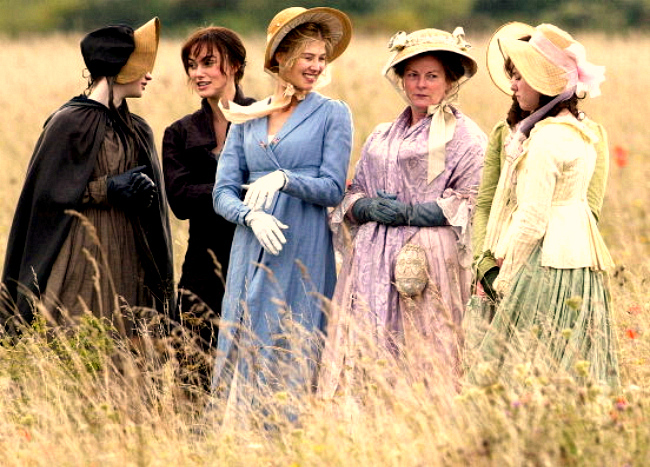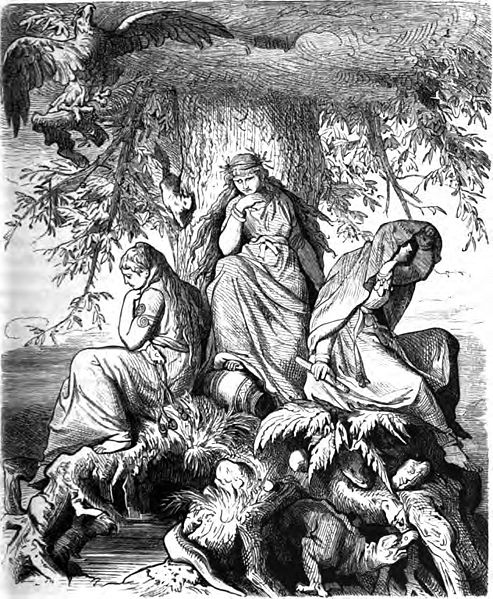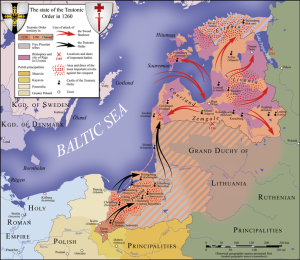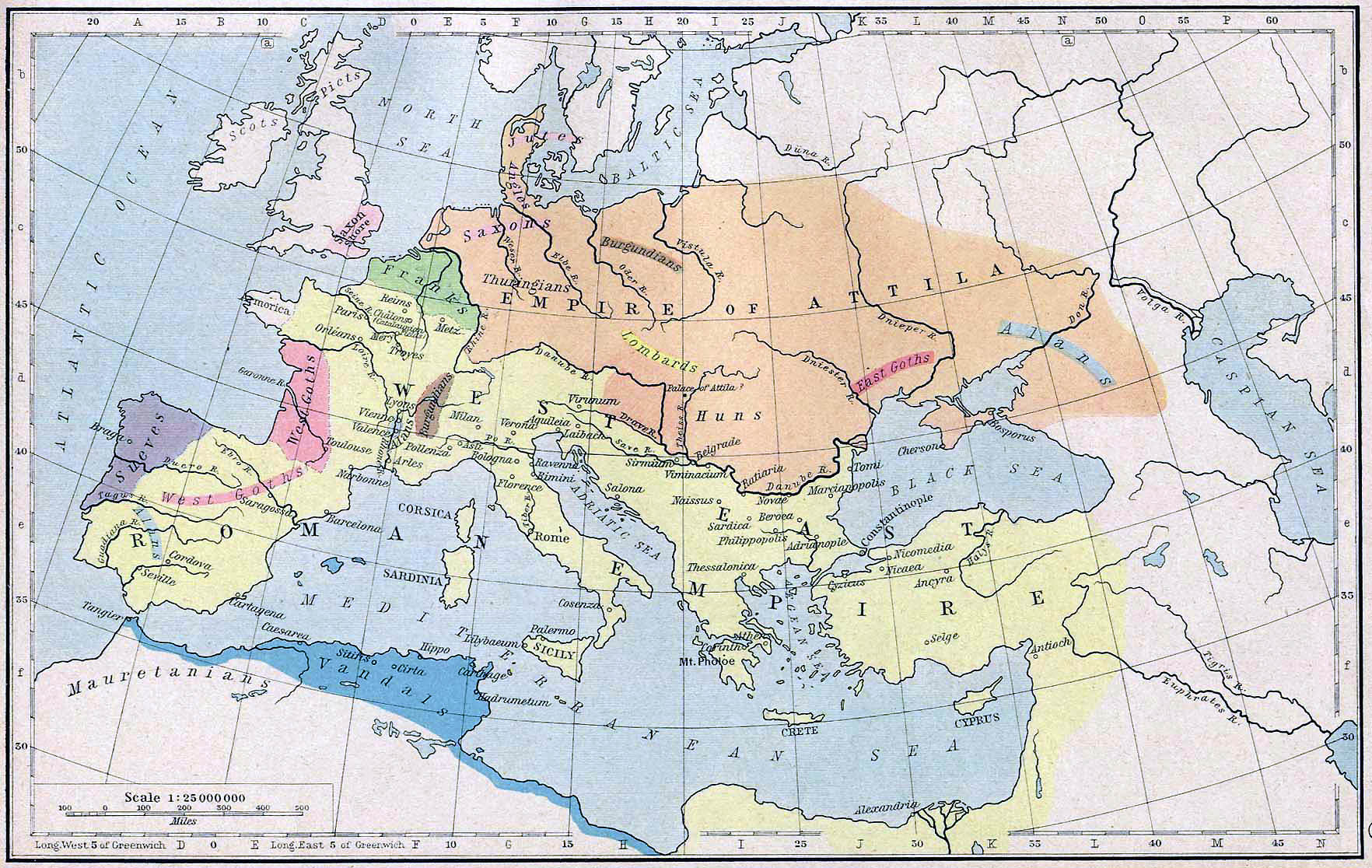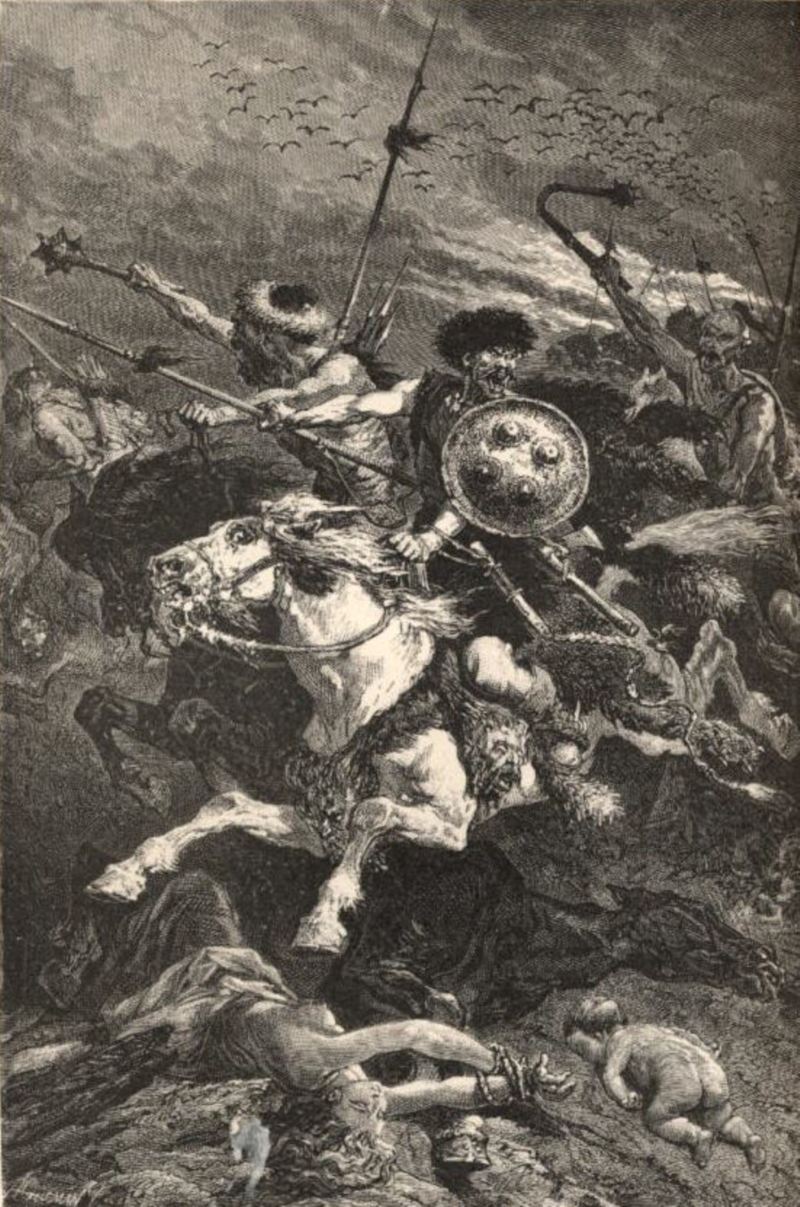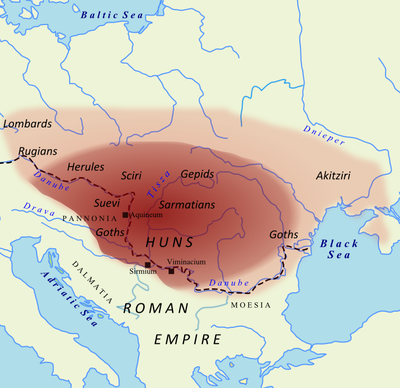Just ignore the PC title of this YouTube clip: ‘Mapping Indo-European language expansion’.
For ‘language’ just replace ‘racial’ or ‘Aryan’ and you’ll get the picture (see Arthur Kemp’s history of the white race for a textual explanation of such expansion).
Tag: Geography
Food for thought from chapter 5 of March of the Titans: The Complete History of the White Race:
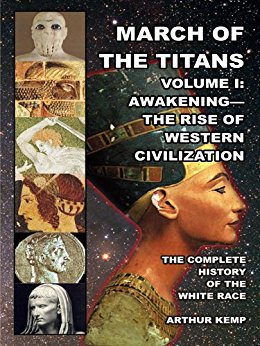
Born of the Black Sea
Many present-day whites are either direct or partial descendants of a great wave of white peoples who swept into Europe from about 5500 BC till around 500 BC.
These peoples, largely Nordic in terms of the white racial sub-groupings, had their original heartland in the region known today as central and southern Russia. Genetic studies of European populations which have emerged since the year 2000 have confirmed the Indo-European invasion.
Melt waters from the retreating ice-sheets at the end of the Pleistocene caused the world’s oceans to rise by almost 100 meters. In 5600 BC, the rising waters of the Mediterranean Sea burst through the narrow neck of the Bosporus, inundating and destroying the civilisations ringing the fertile Black Sea basin. It is this catastrophe which triggered the great Indo-European migrations and spawned the Biblical legend of the flood, familiar to adherents of the Christian faith.
From this heartland in northern Europe—the womb of nations (vagina gentium, as the Romans called the region) successive waves of Indo-European Nordic invaders swept down over a period of centuries into all parts of Europe and into the Near East, conquering or displacing the peoples they found.
Uncle Adolf’s table talk, 19
23rd September 1941, evening
The frontiers of Europe and Asia—Success justifies everything—Our right to fertile lands—The Russian flood must be dammed.
It’s absurd to try to suppose that the frontier between the two separate worlds of Europe and Asia is marked by a chain of not very high mountains—and the long chain of the Urals is no more than that. One might just as well decree that the frontier is marked by one of the great Russian rivers. No, geographically Asia penetrates into Europe without any sharp break.
The real frontier is the one that separates the Germanic world from the Slav world. It’s our duty to place it where we want it to be.
If anyone asks us where we obtain the right to extend the Germanic space to the East, we reply that, for a nation, her awareness of what she represents carries this right with it.
It’s inconceivable that a higher people should painfully exist on a soil too narrow for it, whilst amorphous masses, which contribute nothing to civilisation, occupy infinite tracts of a soil that is one of the richest in the world. We painfully wrest a few metres from the sea, we torment ourselves cultivating marshes—and in the Ukraine an inexhaustibly fertile soil, with a thickness, in places, often metres of humus, lies waiting for us.
We must create conditions for our people that favour its multiplication, and we must at the same time build a dike against the Russian flood. If this war had not taken place, the Reich would scarcely have increased its population during the next ten years, but the Russian population would have grown vigorously.
If to-day you do harm to the Russians, it is so as to avoid giving them the opportunity of doing harm to us. God does not act differently. He suddenly hurls the masses of humanity on to the earth, and he leaves it to each one to work out his own salvation. Men dispossess one another, and one perceives that, at the end of it all, it is always the stronger who triumphs. Is that not the most reasonable order of things?
If it were otherwise, nothing good would ever have existed. If we did not respect the laws of nature, imposing our will by the right of the stronger, a day would come when the wild animals would once again devour us—then the insects would eat the wild animals, and finally nothing would exist on earth but the microbes.
4th February 1942, evening
The call of the South—Struggling through the mud.
We know to-day why our ancestors were not attracted to the East, but rather to the South. Because all the regions lying east of the Elbe were like what Russia is for us to-day. The Romans detested crossing the Alps. The Germanic peoples, on the other hand, were very fond of crossing them—but in the opposite direction. One must bear in mind that at this period Greece was a marvellous garden, in which oak-forests alternated with orchards. It was only later that olive-growing was introduced into Greece.
The reason why the climate has become temperate in Upper Bavaria is that Italy was deforested. The warm winds of the South, which are no longer held in check by the vegetation, pass over the Alps and make their way northwards.
The Germanic needed a sunny climate to enable his qualities to develop. It was in Greece and Italy that the Germanic spirit found the first terrain favourable to its blossoming. It took several centuries to create, in the Nordic climate, the conditions of life necessary for civilised man. Science helped there.
For any Roman, the fact of being sent to Germania was regarded as a punishment—rather like what it used to mean to us to be sent to Posen. You can imagine those rainy, grey regions, transformed into quagmires as far as eye could see. The megalithic monuments were certainly not places of worship, but rather places of refuge for people fleeing from the advance of the mud. The countryside was cold, damp, dreary. At a time when other people already had paved roads, we hadn’t the slightest evidence of civilisation to show. Only the Germanics on the shores of the rivers and the sea-coasts were, in a feeble way, an exception to this rule. Those who had remained in Holstein have not changed in two thousand years, whilst those who had emigrated to Greece raised themselves to the level of civilisation.
The Greek profile, and that of the Caesars, is that of the men of this North of ours, and I’d wager that I could find amongst our peasants two thousand heads of that type.
“The white race must be preserved”
The new racial classification (first part)
First and foremost, if the white race must be preserved, a scientific definition of “white race” must be provided.
Editor’s Abstract: The European race is divided into three primordial races: the European Nordid White (“White Nordid” or WN), the Nordid Central Asian Redhead (“Red Nordid” or RN), and the Near Eastern Armenid. The white race is actually a mixture of two or more races. We cannot say, “This person is a pure white” but “This person has a mixture of A, B and C races in such proportions.” With terms like Aryan or White we designate a mixture between White Nordid and Red Nordid and its mild crossing with non-white “Armenids” or “Mongolids”—usually people of Germanic and Slavic origin.
Therefore, while the ideal white is a White Nordid with a Red Nordid, we cannot say that those whites who have some Armenid or Mongolid genes are non-whites. However, we could say they are non-whites if they have substantial Armenid and/or Mongolid and especially Congid genes.
In the new racial classification the phenotype is more important than genetic studies.
The rest of this long essay can be read at the end of The Fair Race’s Darkest Hour (see the featured post).
I had posted this entry on February 5 but want to repost it so that it may be read along with my previous entry on Nietzsche’s very traditional views about what used to be our most sacred institution before Western man committed racial suicide: Marriage.
The subject of the virtual abolition of Marriage is, to my mind, more important than the Jewish question. Those who want to know why are advised to print Roger Devlin’s article “Sexual Utopia in Power” and study it carefully.
♣
During pre-Christian times Nordics began emigrating in wave after wave heading south. The original Romans, themselves the descendants of one of these waves, would later refer to the German-Scandinavian area as vagina gentium, the womb of white nations. Also, the land which ultimately comprised Russia ought to be hugely significant for white nationalists because it included the Caucasus area, the original source of the “Indo-European” (Caucasian) peoples.
What pained me the most while reading both William Pierce and Arthur Kemp’s stories of the white race is that Europe’s vagina was closed and raped into the Asiatic gene pool in the course of the Asiatic invasions. After those interminable invasions that lasted centuries the Caucasus area ceased to be the womb of the Nordish peoples. “It was perhaps the single most important racial genocide in history” wrote Kemp.
The aggressor was external of course. But during my lifespan I have witnessed the destruction of whites by whites themselves on a scale no seen since the Mongolian invasions. With reproduction levels below the minimum relacement of 2.1 per family, we, not the Huns or Genghis Khan’s hordes, have closed the womb through the so-called sexual liberation movement, feminism, the pill, the legalization of abortion, the empowerment of women, mixed marriages, and the destigmatization of lesbianism and male homosexuality.
It is my hope that, after the dollar crashes and Western society falls into utter chaos—and, thanks to the laws of social entropy, ethno-states are formed at both sides of the Atlantic—, Roger Devlin’s dream to reinstitute heterosexual marriage will become reality.
If our civilization is under the grip of liberal mores, especially the belief that non-discrimination on race and gender is the highest moral value, when values are transvaluated back to Austen mores our women will be having six or more kids.
If whites are to survive as a people the vagina gentium must be reopened, whether our spoiled women like it or not…

Excerpted from
March of the Titans:
A History of the White Race
by Arthur Kemp:
Although originating within the Semitic world, the religion of Christianity has played such a major role in the post Roman European world that its origins must be clearly dealt with for the sake of understanding its later influence.
Genocidal evangelism
Coercive Christianity takes root
With the use of violent and bloody coercion, Saxon and German paganism was quite literally killed off, and most of the survivors became Christians more out of fear than out of genuine conviction. Christianity finally spread to the Goths themselves, through a Christian slave named Wulfila, who translated the Bible into Gothic.
Before the end of the fourth century, Christianity had spread to the Vandals, the Burgundians, the Lombards and other German tribes within the direct sphere of influence of the Western Roman Empire.
By the year 550 AD, the only non-Christian tribes were to be found in Bavaria and those parts of Germany north from there—including virtually all of the Danes, Scandinavians, Balts and Slavs to the east.
Charlemagne organizes the murder of all non-Christians under his control
In 768, Pepin’s son, Charlemagne (Charles the Great), inherited the Frankish kingdom. It was this king who was directly responsible for the introduction of Christianity to the Germans.
To destroy German paganism, Charlemagne proclaimed harsh laws applicable to those Germans under his control who refused to be baptized into Christianity. Eating meat during Lent, cremating the dead and pretending to be baptized were all made punishable by death.
In 768, Charlemagne started a 32 year long campaign of what can only be described as genocidal evangelism against the Saxons under his control in western Germany.
The campaign started with the cutting down of the Saxon’s most sacred tree, their version of the World Tree or Yggdrasil (the symbol of the start of the earth and the source of all life in the ancient Indo-European religions) located in a sacred Saxon forest near present day Marburg.
The norns Urðr, Verðandi,
and Skuld beneath
the world tree
Yggdrasil
Charlemagne quickly turned to violence as a means of spreading the Christian word. In 772, at Quierzy, he issued a proclamation that he would kill every Saxon who refused to accept Jesus Christ, and from that time on he kept a special detachment of Christian priests who doubled as executioners, and in every Saxon village in which they stopped, these priests would execute anybody who refused to be baptized.
Then in 782, at Verden, Charlemagne carried out the act for which he is most notoriously associated—he ordered the beheading of 4,500 Saxons in one day who had made the error of being caught practicing paganism after they had agreed to be Christians.
Charlemagne’s constant companion and biographer, the monk Einhard, vividly captured the event in his biography of the Frankish king. In it is written that the King rounded up 4,500 Saxons who “like dogs that return to their vomit” had returned to the pagan religions they had been forced to give up upon pain of death.
After having all 4,500 Saxons beheaded “the king went into winter camp, and there celebrated mass as usual.”
Twelve years later, in 794, Charlemagne introduced a law under which every third Saxon living in any pagan area was kidnapped and forced to resettle and be raised amongst Christian Franks.
Teutonic Knights exterminate the last white pagans
The only significant grouping of Whites left in Europe who were not—nominally at least—Christians by the year 1000 AD were to be found in the Baltic and Eastern European regions. To destroy this last bastion of paganism the Church employed the services of some of the most fanatic Christians of all—the Teutonic Knights.
By 1198, however, these knights had changed from being purely passive and took an active part in the war against the non-White Muslims, becoming known as the Teutonic Knights. Membership in the order was strictly limited to Christian German noblemen. The Teutonic Knights received official recognition from Pope Innocent III in 1199, and adopted the official uniform of a white tunic with a black cross.
Soon their deeds on behalf of Christendom became famous. In 1210 they were invited to Hungary by the king of that country to participate in a war against the non-Christian pagan tribes in Eastern Europe.
The Teutonic Knights jumped at the chance, and by using violence and mass murder, soon became known as effective Christianizers amongst the pagan Whites of Eastern Europe. This genocidal evangelism soon became the sole obsession of the Teutonic Knights—by 1226 the order had set up permanent settlements in north eastern Europe.
In 1226, the Holy Roman Emperor granted the Teutonic Knights control over what was then Prussia (today northern Poland) to rule as a fiefdom on condition that they convert all the locals to Christianity. In 1234, Pope Gregory IX granted the Knights control over any other territory that they might conquer from the pagans. The Teutonic Knights soon built a series of imposing castles to defend their new territory, some of which still stand today.
From the safety of these castles they waged their own brand of evangelicalism, which was limited to the Frankish king Charlemagne’s recipe—once a number of pagans had been captured, they were offered the choice of either being baptized and accepting Christianity, or being killed on the spot.
Unsurprisingly, almost all chose conversion. The price for being caught practicing paganism after being baptized, was instant death.
The Teutonic Order in 1260
As was the case with the genocidal evangelicalism of Charlemagne, the first one or two generations of converts were in all likelihood not genuine—usually they paid lip service to Christianity in order not to be killed. By about the third generation however, the children knew no other religion, and in this way Christianity replaced the original Indo-European religions.
The Teutonic Knights also encouraged already Christianized Germans to settle in Prussia. This served a double purpose—not only could the new arrivals police the new converts, but also the Teutonic Knights realized very clearly that the easiest way to change the nature of a society was to change its inhabitants.
By 1300, the Teutonic Knights were one of the most powerful organizations in Germany, controlling territory which stretched from the Baltic Sea into central Germany, a private empire which saw them engaging in, on average, eight major wars every year.
However, the Teutonic Knights slowly ran out of pagans to convert. By 1386 the last of the major non-Christian tribes in the north, the Lithuanians, had all more or less been converted, and the order started to lose the reason for its existence.
Later Christianity
So it was that Christianity came to be the dominant religion of Europe—the first religion to convert by mass murder.
The original White religion had never tried to convert followers upon pain of death, and had never waged a war in its name—and as such it was psychologically unprepared to do battle with a Middle Eastern religion which engendered a genocidal fanaticism amongst its followers.
Once the Christians had run out of pagans to kill, they turned upon themselves in a violent and bloody fratricidal conflict which saw the Church split and the various protagonists kill each other in a crazed blood lust.
Fully one third of the entire White race was killed in a series of major Christian Wars in Europe—these events are dealt with in a later chapter, along with the effect of Christianity upon the development of science, history, art and social life.
The Dark Ages
The Dark Ages was a period in European history which has been arbitrarily set at between approximately 800 AD and lasting until the Renaissance. Although this is by no means a fixed definition, the common thread throughout this period of history was the total dominance of Christianity and the repression of all art, science and progress that was not Christian in nature.
In this way the great scientific, philosophical and cultural works of the thousands of years of pre-Christian civilization were suppressed, all being ascribed to the work of pagans and therefore of devil authorship. The era became known as the Dark Ages because of the introduction of theocracy as the only guideline in all fields of endeavor. This created a halt to all progress and centuries of cultural stagnation, which marked the time between the glory of Classical antiquity and the rebirth of that glory in the Renaissance and the beginnings of the modern world.
In the field of the study of history, the dominance of the Church had a massive effect. The Lux Ex Orient (“the Light Comes from the East”) doctrine was established which said that all civilization originated in the Middle East, as this was where the events of the Bible had supposedly been played out. The Lux Ex Orient doctrine is still to this day the “popular” interpretation of history, with most people having been taught that “civilization originated in the fertile river valleys”.
Racial effects of the age of theocracy
The spread of Christianity unquestionably affected the growth of the European peoples: particularly in the policy, still held in the Catholic Church to this day, of celibacy for leading church officials.
Although this policy of enforced celibacy amongst the priesthood, monks and nuns only ever applied to a relatively small number of Whites, it was nonetheless often the most intelligent members of society who became monks or nuns. This was so because during the Dark Ages, only the cleverest candidates were allowed to enter the priesthood: as the keepers of the arts and writing, the only way to gain any sort of education was to join the priesthood.
Although there can be little doubt that, given human nature, the celibacy rule was broken, it must also be so that the policy of deliberate celibacy saw many thousands of Europe’s cleverest people dying childless, their genes lost forever. The persecution of these great minds with the accusation of paganism also unquestionably stripped Europe of many of its cleverest people: the cumulative effect of the Dark Ages was to set Europe back centuries in development.
The Christian Wars
In the New Testament, Jesus Christ is quoted as saying that he had come to bring the sword, to “set father against son and mother against daughter” (Luke 12:53) and called on his followers to “But those mine enemies, which would not that I should reign over them, bring hither, and slay them before me” (Luke 19:27).
These words have, in the history of Christianity, been enacted in bloody reality many times—starting when an important political rebellion against the Roman Catholic Church took on a religious slant—leading to the split in European Christendom between Catholic and Protestant. This split sparked off a series of religious wars which were ultimately to be responsible for the death of nearly a third of the entire White race.
The Reformation is the name given to this 16th century religious uprising. Its major outpouring happened in the middle of the Renaissance, there can be little doubt that the two events were linked: added to this was a political problem which the countries in Northern Europe had with the all powerful role the pope had assumed from Rome.
Emerging European nationalism objected to the fact that the pope—usually an Italian—had to approve the appointment of any head of state everywhere else in Europe. The pope’s ability to even charge tax from foreign countries to support the Church headquarters in Rome also irked those living thousands of miles from Rome. It has been estimated that the Church ended up owning as much as one third of all the land in Europe in this manner: what the various national states must have secretly thought of this does not need to be imagined.
[After a few pages describing the religious wars, Kemp writes:]
The Danes were defeated: the Catholics followed up their victory with another Danish defeat in August of that year at Lutter am Barenberge, Germany.
The Danes fled back north, and the Catholic armies set about pillaging, looting and destroying every Protestant north German town they seized. Catholic victory seemed complete: in March 1629, the Catholic king issued the Edict of Restitution which effectively nullified all Protestant titles to all Roman Catholic property expropriated since the Peace of Augsburg in 1555.
The German Protestant city of Magdeburg then rose in revolt: it was besieged by a German Catholic army and crushed in May 1631, with every single Protestant inhabitant—tens of thousands of people—being massacred by the victorious Catholics. The city was also virtually burned to the ground in the looting that followed.
Racial consequences of the Thirty Years’ War – One Third of German population killed
The racial consequences of the Christian Wars, and in particular the Thirty Years’ War, were vast. The German population was reduced by at least one third, and probably more: when combined with the effects of the Great Plague of the 1300s, the German population actually shrunk by over 50 per cent in the course of 300 years: a massive decline which, if avoided, would certainly have changed the course of world history.
When the history of the Christian Wars is read in conjunction with the suppression of learning and science caused by the Christian Dark Ages, and the division the White populations into opposing Christian camps, then no other conclusion is possible except to say that the introduction of Christianity has to count as the single greatest ideological catastrophe to ever strike Europe.
Note:
For excerpts of all chapters of Kemp’s book see: here.
Excerpted from the 17th article of William Pierce’s “Who We Are: a Series of Articles on the History of the White Race”:
The Huns halted their westward push for more than 40 years while they consolidated their hold on all of central and eastern Europe, and on much of northern Europe as well. In 433 they gained a new king, whose name was Attila. In 445, when Attila established his new capital at Buda, in what is now Hungary, the empire of the Huns stretched from the Caspian Sea to the North Sea.
In 451 Attila began moving west again, with the intention of seizing Gaul and then the rest of the Western Empire. His army consisted not only of Huns but also of contingents from all the conquered peoples of Europe: Ostrogoths, Gepids, Rugians, Scirians, Heruls, Thuringians, and others, including Slavs.
One contingent was made up of Burgundians, half of whom the Huns had subjugated (and nearly annihilated) in 436. The struggle between the Burgundians and the Huns forms the background for the German heroic epic, the Nibelungenlied.
Scourge of God
Attila’s mixed army threw western Europe into a state of terror as it advanced. So great was the devastation wrought on the countryside that Attila was given the nickname “the Scourge of God,” and it was said that grass never again grew where his horse had trod.
Two armies, one commanded by Aëtius, the last of the Western Empire’s Roman generals, and the other by Theodoric, King of the Visigoths, rode against Attila. Aëtius and Theodoric united their armies south of the Loire, in central Gaul, and compelled Attila to withdraw to the north-east.
Attila carefully chose the spot to halt his horde and make his stand. It was in a vast, open, and nearly level expanse of ground in northeastern France between the Marne and the Seine, where his cavalry would have ideal conditions for maneuvering. The region was known as the Catalaunian Plains, after the Catalauni, a Celtic people. The name of Chalons (ancient Catalaunum), is most often associated with the battle which took place on the Catalaunian Plains, although the actual site is much closer to the city of Troyes.
White Victory
In a furious, day-long battle frightful losses were inflicted on both sides, but the Visigoths, Franks, free Burgundians, and Alans of Aëtius and Theodoric had gained a decisive advantage over the Huns and their allies by nightfall. Attila retreated behind his wagons and in despair ordered a huge funeral pyre built for himself. He intended neither to be taken alive by his foes nor to have his corpse fall into their hands.
King Theodoric had fallen during the day’s fighting, and the command of the Visigothic army had passed to his son, Thorismund. The latter was eager to press his advantage and avenge his father’s death by annihilating the Hunnic horde.
Empire of Attila (orange) by 450 A.D.
The wily Roman Aëtius, however, putting the interests of his dying Empire first, persuaded Thorismund to allow Attila to withdraw his horde from Gaul. Aëtius was afraid that if Thorismund completely destroyed the power of the Huns, then the Visigoths would again be a menace to the Empire; he preferred that the Huns and the Visigoths keep one another in check.
Battle of the Nedao
Attila and his army ravaged the countryside again, as they made their way back to Hungary. The following year they invaded northern Italy and razed the city of Aquileia to the ground; those of its inhabitants who were not killed fled into the nearby marshes, later to found the city of Venice.
But in 453 Attila died. The 60-year-old Hun burst a blood vessel during his wedding-night exertions, following his marriage to a blonde German maiden, Hildico (called Kriernhild in the Nibelungenlied). The Huns had already been stripped of their aura of invincibility by Theodoric, and the death of their leader diminished them still further in the eyes of their German vassals.
The latter, under the leadership of Ardaric the Gepid, rose up in 454. At the battle of the Nedao River in that year it was strictly German against Hun, and the Germans won a total victory, completely destroying the power of the Huns in Europe.
Slavic Opportunity
The vanquished Huns fled eastward, settling finally around the shores of the Sea of Azov in a vastly diminished realm. They left behind them only their name, in Hungary. Unfortunately, they also left some of their genes in those parts of Europe they had overrun. But in 80 years they had turned Europe upside down. Entire regions were depopulated, and the old status quo had vanished.
This provided an opportunity for the Slavs to expand, and they took advantage of it, as mentioned earlier. Unfortunately for them—and for our entire race—the area into which the Slavs expanded corresponded largely to the area invaded repeatedly in later centuries by Asiatic hordes from the east, and the Slavic peoples suffered grievously. We will examine these Asiatic invasions in later installments.
Excerpted from the 17th article of William Pierce’s “Who We Are: a Series of Articles on the History of the White Race”:
The Gothic nation, as was mentioned in the previous installment, had established itself on the southern shore of the Baltic, around the mouth of the Vistula, before 300 B.C. Prior to that the Goths had lived in southern Sweden.
Conquest of the Steppe
The Goths west of the Dniester—the Visigoths—moved down into the Danubian lands west of the Black Sea, where they inevitably came into conflict with the Romans. They conquered the Roman province of Dacia for themselves, after defeating a Roman army and killing a Roman emperor (Decius) in the year 251.
For the next century and a quarter both the Visigoths and the Ostrogoths prospered, while the fortunes of the Roman Empire continued to decline. The Goths, who were excellent seamen, raided the Black Sea coastal cities of Asia Minor at will, and Rome was also hard pressed to defend other portions of her long border with the Germans.
Peaceful Coexistence
Toward the end of the third century, during the reign of Diocletian, the Empire was divided into eastern and western halves, for administrative and military purposes. The progressive breakdown of communications led eventually to separate de facto powers, one centered in Rome and the other in Byzantium (later renamed Constantinople).
During the first three-quarters of the fourth century, despite occasional raids, a state of relatively peaceful coexistence between Goths and Romans pervaded. Especially in the eastern half of the Empire, diplomacy and bribery were used to hold the Goths at bay. During the reign of Constantine (306-337) 40,000 Goths were recruited into the Roman army, and they thenceforth were the bulwark of the Eastern Empire.
It was in the reign of Emperor Valens, in the year 372, that the greatest menace to the White race, both Germans and Romans, since the beginning of recorded history suddenly appeared on the eastern horizon. From the depths of Central Asia a vast horde of brown- skinned, flat-nosed, slant-eyed little horsemen—fast, fierce, hardy, bloodthirsty, and apparently inexhaustible in numbers—came swarming across the steppe around the north end of the Caspian Sea. They were the Huns.
The first to feel their impact were the Alans, living south of the Don between the Black Sea and the Caspian Sea. The Hunnic horde utterly crushed the Alans, some of whose remnants retreated southward into the Caucasus Mountains, while others fled westward in confusion, seeking refuge among the Goths. In the Caucasus today traces of the Nordic Alans are found in the Ossetes, whose language is Indo-European and who are taller and lighter than the Caucasic-speaking peoples around them.
End of the Ostrogoths
Next the Huns fell upon the Ostrogoths and routed them. The aged Ostrogothic king, Hermanric, slew himself in despair, and his successor, Vitimer, was killed in a vain effort to hold back the Brown flood. The Ostrogothic kingdom disintegrated, and its people streamed westward in terror, with the Huns at their heels. Athanaric, king of the Visigoths, posted himself at the Dniester with a large army, but the Huns crossed the river and defeated him, inflicting great slaughter on his army.
Thus, the Visigoths too were forced to retreat westward. Athanaric petitioned Valens for permission for his people to cross the Danube and settle in Roman lands to the south. Valens consented, but he attached very hard conditions, which the Goths, in their desperation, were forced to accept: they were required to surrender all their weapons and to give up their women and children as hostages to the Romans.
Oppression and Rebellion
The Goths crossed the Danube in 376 and settled in the Roman province of Lower Moesia, which corresponds roughly to modern Bulgaria. There the Romans took shameful advantage of them. Roman-Jewish merchants, in return for grain and other staples, took the hostage children of the Goths as slaves.
The Goths secretly rearmed themselves and rose up. For two years they waged a war of revenge, ravaging Thrace, Macedonia, and Thessaly. Finally, on August 9, 378, in the great battle of Hadrianople, the Gothic cavalry, commanded now by Fritigern, annihilated Valens’ infantry (most of whom were also Goths), and the emperor himself was killed. This was the worst defeat Rome had suffered since the Goths defeated and killed Decius 127 years earlier, and the battle decisively changed the conduct of future wars. Heretofore, Roman infantry tactics had been considered unbeatable, but Fritigern’s Goths had shown what heavy cavalry could do to infantry unprotected by its own cavalry.
The emperor of the eastern half of the Empire who succeeded Valens took a much more conciliatory stance toward the Goths, and they were confirmed in their possession of much of the territory south of the Danube which they had seized between 376 and 378. The Huns, meanwhile, had occupied Gothic Dacia (present-day Romania), as well as all the lands to the east.
Loss of a Homeland
The ancient homeland of the Nordic race was now in the hands of non-Whites. For more than four millennia wave after wave of White warriors had come out of the eastern steppe to conquer and colonize Europe: Achaeans, Dorians, Latins, Celts, Germans, Balts, Slavs, Cimmerians, Scythians, Sarmatians, and uncounted and unnamed peoples before all these. But the Sarmatians were the last; after the Huns drove them and the Goths out, no other White barbarians were to come riding out of the east.
For the next thousand years the eastern steppe which had been the breeding ground of the Nordic race became the invasion route into Europe for periodic waves of non-White hordes from Asia: Huns, Avars, Turks, Magyars, Mongols.
German vs. German
The Huns contented themselves, for the time being, with that portion of Europe between the Carpathians and the Danube, leaving the Romans and the Germans elsewhere to their own devices. Rome, a hollow shelf peopled largely by Levantines and ruled in effect by a gaggle of filthy-rich Middle Eastern moneylenders, speculators, and merchants, depended for her continued existence upon cleverness and money rather than real strength. Germans menaced her and Germans defended her, and the Romans concentrated their energies on playing German off against German.
The game succeeded in the Eastern Empire, more or less, but not in the Western Empire. A Frank, Arbogast, was the chief adviser—and effective master—of Western Emperor Eugenius in the year 394, having assassinated Eugenius’ predecessor. The emperor of the East, Theodosius, sent his Gothic army against Arbogast, and Arbogast called on his fellow Franks for support. The two German armies fought at Aquileia, near modern Venice, and the Goths defeated the Franks.
Alaric the Bold
Two of the leaders of Theodosius’ army were Alaric the Bold, a Gothic prince, and Stilicho, a Vandal. After the battle of Aquileia Stilicho, nominally subordinate to Theodosius, became the effective master of the Western Empire. Alaric was chosen king of the Visigoths by his tribe and decided to challenge Stilicho, but as long as Stilicho lived he was able to hold Alaric at bay.
The emasculated and Levantinized Romans, unable to face the Germans man to man, bitterly resented their German allies as much as they did their German enemies. This resentment, born of weakness and cowardice, finally got the better of the Romans in 408, and they conspired to have their protector, Stilicho, murdered. Then the Romans in all the Italian cities butchered the wives and children of their German allies—60,000 of them.
This foolish and brutal move sent Stilicho’s German soldiers into Alaric’s arms, and Italy was then at the Goth’s mercy. Alaric’s army ravaged large areas of the peninsula for two years in revenge for the massacre of the German families. Alaric demanded a large ransom from the Romans and forced them to release some 40,000 German slaves.
Fall of Rome
Then, on the night of August 24, 410, Alaric’s Goths took Rome and sacked the city. This date marked, for all practical purposes, the end of the capital of the world. Rome had endured for 1,163 years and had ruled for a large portion of that time, but it would never again be a seat of power. For a few more decades the moribund Empire of the West issued its commands from the fortress city of Ravenna, 200 miles north of Rome, until the whole charade was finally ended in 476. The Empire of the East, on the other hand, would last another thousand years.
Excerpted from the 15th and 16th articles of William Pierce’s “Who We Are: a Series of Articles on the History of the White Race”:
The philosopher Lucius Annaeus Seneca, also writing in the first century, shared Tacitus’ respect for the Germans’ martial qualities: “Who are braver than the Germans? Who more impetuous in the charge? Who fonder of arms, in the use of which they are born and nourished, which are their only care?”
Caesar, Tacitus, and other writers also described other attributes of the Germans and various aspects of their lives: their shrines, like those of the Celts and the Balts, were in sacred groves, open to the sky; their family life (in Roman eyes) was remarkably virtuous, although the German predilection for strong drink and games of chance must have been sorely trying to wives; they were extraordinarily hospitable to strangers and fiercely resentful of any infringements on their own rights and freedoms; each man jealously guarded his honor, and a liar was held in worse repute than a murderer; usury and prostitution were unknown among them.
[Here Pierce recounts the clash between the Germanics and the Romans under Caesar, Augustus and Tiberius. Then he adds:]
Five Decisive Things
During the 401 years between Hermann’s victory in the Teutoburger Forest and the sacking of the city of Rome by a German army in August 410, a great many things of historical importance occurred. We will be able to look at only a few of them in detail, however; we do not want to be distracted from our history of the race by the minutiae of political history, no matter how important.
Five things which happened or were ongoing during this period stand out as decisive, from a racial viewpoint. First, there was the continued decadence of the Romans, a matter we have already treated. Second, there was the growing Germanization of the Roman army. Third, there was the migration of the Goths from their home in Scandinavia back to the ancient Indo-European homeland in southern Russia. Fourth, there was the invasion of Europe by a non-White horde from the Far East: the Huns. And fifth, there was the final undermining of Roman strength by the spread of a new religion from the Levant—an Oriental religion of pacifism and egalitarianism which also began to have an effect on the Germans.
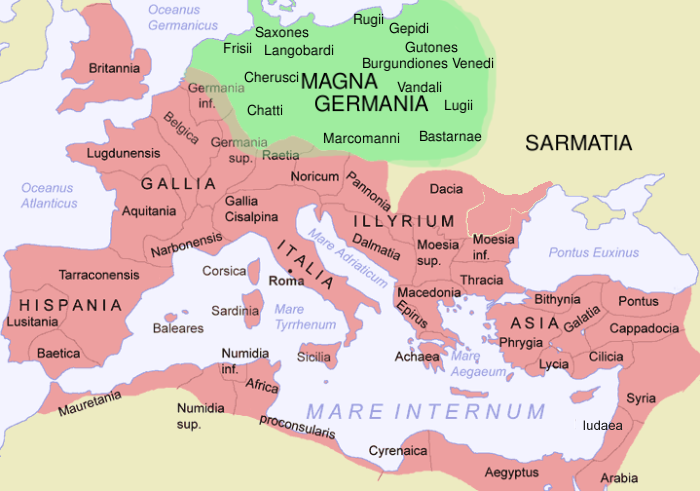 When Marcus Aurelius, the last Roman emperor able to inspire any real fear or respect in the Germans, tried to recruit troops to defend Rome’s Danubian border in 168, not even the threat of death induced Italians to enlist in the legions. The emperor finally resorted to conscripting all of Rome’s gladiators, most of whom were Celtic or German prisoners of war, into the army, whereupon the Roman masses, as addicted to their spectator sports as America’s masses are to their TV, threatened insurrection. “He deprives us of our amusements,” the populace cried out in anger against the emperor, “in order to make us philosophers like himself.” As they had become less martial, the Romans—or, rather, the Jews, Syrians, Egyptians and debased Greeks of the Empire who unworthily bore that once-honorable name—had grown ever more fond of the cruel blood sports of the Colosseum.
When Marcus Aurelius, the last Roman emperor able to inspire any real fear or respect in the Germans, tried to recruit troops to defend Rome’s Danubian border in 168, not even the threat of death induced Italians to enlist in the legions. The emperor finally resorted to conscripting all of Rome’s gladiators, most of whom were Celtic or German prisoners of war, into the army, whereupon the Roman masses, as addicted to their spectator sports as America’s masses are to their TV, threatened insurrection. “He deprives us of our amusements,” the populace cried out in anger against the emperor, “in order to make us philosophers like himself.” As they had become less martial, the Romans—or, rather, the Jews, Syrians, Egyptians and debased Greeks of the Empire who unworthily bore that once-honorable name—had grown ever more fond of the cruel blood sports of the Colosseum.
All-Volunteer Army
Until the end of the third century law prohibited the enlistment of foreigners in the Roman army. Although the law was often violated, it resulted in most of Rome’s soldiers being recruited from among the Celts and Germans of the conquered provinces during a period of about 150 years. By the time of Constantine not even the provinces could provide enough soldiers to defend the degenerate Roman Empire, and the greatest source of military manpower became the free Germans, who enlisted for purely mercenary motives.
By the middle of the fourth century, the Roman army was Roman in name only. Germans not only filled the ranks, but most of the officers, up to the highest levels of command, were Germans as well. Thus, the more or less continual state of war which existed between the free Germans and the Roman Empire during the third, fourth, and fifth centuries—up until 476, when the last Roman emperor was deposed and banished and a German leader ruled Italy as king—was not fought between Germans and Romans, but between Germans on the one side and Germans on the other.
Gold for Blood
The Romans bought their protection instead of fighting for it. Gold paid for blood for more than 200 years, but in the end all their money and their civilized cleverness were not enough.
If the Germans could have added a stronger sense of racial solidarity to their other virtues, they could have put an end to the sewer that was Rome 200 or even 300 years sooner than they did. They would not only have avoided spilling torrents of their own blood, but they could have stamped out a source of poison that, allowed to continue festering, ultimately would infect them.
Declining Rome’s many wars with the Germans involved a number of tribes. The incursions across the Danube into Pannonia that Marcus Aurelius bloodily repulsed in the second century were by tribes confederated with the Marcomanni, for example. During the third and fourth centuries the Franks raided across the Rhine into Gaul, and the Saxons harassed the coasts of that country and Britain. But it was the Goths above all the others who wrote the final chapters of the struggle between Germany and Rome.
Gothic Victory
After several skirmishes between Goths and Romans along the lower Danube, in the year 251 the Goths inflicted the worst defeat on the Romans they had suffered since the Hermannschlacht, annihilating a Roman army and killing its commander, the emperor Decius.
Within two more decades Rome had abandoned all claim to Dacia, and the province which Trajan had conquered 150 years earlier was thenceforth firmly in German hands, with the Danube once again the border between Rome and Germany.


